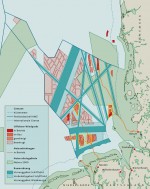
Protecting the seas is possible
Successes at the local level and in the international arena
Comprehensive and sustainable use of the marine environment is still a long way off: that is evident from the continuing overexploitation of fish stocks in European waters, the oil pollution in the Niger Delta and the eutrophication of the Yellow Sea off mainland China. On the other hand, there are many positive examples which prove that protecting the seas is possible – both at global and at regional or local level. The motivations for protecting the marine environment and moving towards sustainability vary considerably, as do the methods by which this is achieved. In some cases, massive public pressure has resulted in higher standards of protection or the use of improved technologies. In others, there were sound economic arguments for implementing appropriate measures. Often, a detailed costbenefit analysis revealed that investing in sustainability was the more cost-effective option.
- 4.7 > Emission Control Areas (ECAs) are sea areas in which shipping is subject to stricter emissions limits. Environmental organizations are calling for ECAs to be established in other coastal regions with a high volume of shipping traffic.

Cleaner shipping
In some instances, it takes time for states to reach agreement on marine protection regimes. Indeed, this is often only possible if the rules are not too stringent or the negotiating partners set long deadlines for achieving specific goals. This search for the lowest common denominator does not necessarily mean a poor compromise; it is often a crucial step in the right direction. A topical example is the reduction of harmful emissions from the burning of cheap, low-grade heavy fuel oil (HFO) in shipping. Ships running on HFO emit large quantities of sulphur oxides (SOX), nitrogen oxides (NOX) and particulate matter (soot) in their exhaust gases, which can cause respiratory diseases. While catalytic converters in vehicles and cleaner heating and industrial systems have done much to reduce air pollution in many ports, ships continue to emit their unfiltered exhaust gas into the atmosphere. In some dockland areas, the concentration of air pollutants reached such high levels in recent years that new waterside housing projects were put at risk. There was also pressure from the tourism industry: the growing number of cruise ships led to a deterioration in air quality in the very coastal resorts that are popular with passengers and advertise the fact that they offer clean and fresh seaside air.
- In order to improve the situation, the member states of the International Maritime Organization (IMO) agreed that the emission limit values (caps) had to be reduced. Limit values are set under an IMO agreement, the International Convention for the Prevention of Pollution from Ships (MARPOL 73/78). MARPOL contains several annexes specifying in detail which particular types of pollution are prohibited. The new caps on exhaust gas are set out in Annex VI to the Convention. Among other things, the sulphur content in heavy fuel oil is to be reduced worldwide. Until 2012, a maximum sulphur content of 4.5 per cent was permitted. This was lowered to 3.5 per cent in 2012, and will be reduced to a mandatory 0.5 per cent globally, although this will not happen until 2020.
In addition, Annex VI to the Convention defines various sea areas – known as Emission Control Areas (ECAs) – in which more stringent regulations apply.
Emission Control Areas have been established for some of the busiest shipping routes where the adoption of special mandatory measures for emissions from ships is required to prevent, reduce and control coastal air pollution. These special areas currently include the English Channel, the North Sea and the Baltic Sea, where there is a high volume of shipping traffic, and the waters off the coast of the US and Canada. A 1.5 per cent maximum sulphur content in fuel applied in the Baltic from 2006 and in the North Sea from 2007, and this was lowered to 1.0 per cent in 2010 and then to 0.1 per cent from January 2015.
- 4.8 > Exhaust gases from shipping are a problem in many ports, such as Hamburg (above). Under IMO rules, these exhaust gases will contain lower levels of pollutants in future. Black smoke cannot be avoided altogether, however: it is emitted in short bursts from ships’ revving engines during docking.
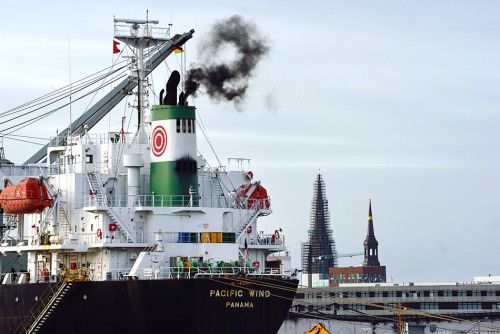
- Noxious emissions from shipping can be abated if vessels switch to much more expensive diesel, or are fitted with marine exhaust gas cleaning systems. Both options increase the costs to the shipping companies, which vigorously opposed tighter emission limit values for many years. Environmental organizations therefore view the decision to allow vessels to continue to burn heavy fuel oil with a very high sulphur content (3.5 per cent) in international waters until 2020 as a concession to the shipping companies. The fact that these limit values were adopted at all, despite opposition from the shipping industry, is due to the cost-benefit ratio. Ports and coastal towns benefit from a thriving shipping industry, transshipment and cruise tourism as these sectors generate income. However, the tourism industry and local communities are vocal in their opposition to air pollution, with mounting public pressure against emissions from shipping in recent years, especially in the ECAs. Cruise ships and larger commercial vessels are therefore required to switch to diesel when lying at anchor in the ECAs. The more stringent IMO rules are intended to reduce air pollution from passing ships in future as well. The benefits, then, are better air quality in the ECAs and less conflict between the shipping industry, on the one hand, and tourism and ports/coastal communities, on the other. Environmental organizations are now calling for other sea areas, such as the Mediterranean, to be designated as ECAs.
- he MARPOL Convention is an international treaty, and compliance is therefore mandatory under international law. States which have acceded to the Convention are thus permitted to verify a vessel’s compliance with these more stringent emissions limits and, indeed, with MARPOL’s other provisions while the vessel is in port. Under this system of Port State Control (PSC), authorities may also levy fines for non-compliance, which must be paid immediately in cash. Vessels or their flag state may also incur penalty points under an international points system. The penalty point system enables persistently non-compliant vessels to be flagged up in the international databases, with the result that their masters must expect the checks to be repeated in other ports en route.
Moratorium
A moratorium is an agreement on the suspension of an activity, by which states undertake not to exercise their use rights or enforce claims to payments. A moratorium generally remains in force for a limited period. Various states or communities such as the Greenlandic Inuit, which depend on subsistence whaling, are exempt from the whaling moratorium. The International Whaling Commission (IWC) discusses such exemptions at its regular meetings.The end of commercial whaling
The commercial whaling moratorium is another example of a successful international agreement. Adopted by the members of the International Whaling Commission (IWC) in 1982 following the dramatic decline of many whale populations, the moratorium entered into force in 1986, spelling the end for the commercial hunting of the great whales. Progress towards this goal was fraught with difficulty, however.
The IWC was established in 1948 by 14 member countries, all of which were engaged in commercial whaling on a relatively large scale. At that time, the IWC’s main purpose was to set whaling quotas, which were then allocated to the individual member countries. As the quotas were not based on whale numbers but were simply intended to ensure that the profits from whaling were shared as fairly as possible, whales were hunted relentlessly. In 1961/1962 alone – a record season – some 66 000 whales were killed worldwide. Studies undertaken in the Southern Ocean in the early 1960s revealed the severely depleted status of the whale populations for the first time. Catch limits, e.g. for blue whales and humpback whales, were agreed within the IWC framework on various occasions, but several of the whaling nations opposed the restrictions and whaling continued. As whale populations steadily declined, the first of the major UN environmental conferences – the United Nations Conference on the Human Environment (UNCHE) in 1972 – called for a moratorium on commercial whaling, initially for 10 years. Nevertheless, whaling continued, whereupon various environmental organizations began to protest more vigorously against whaling – in some cases with headline-grabbing campaigns in which activists on inflatable boats attempted to disrupt whaling operations at sea. In many countries, there was a shift in public mood, with growing opposition to whaling. In 1982, Seychelles abandoned commercial whaling and proposed a moratorium for the first time.
- Until that point, the IWC had mainly consisted of countries which were engaged in or supported whaling. However, the IWC is an international organization and is open to any country in the world, and now it began to attract more countries which were opposed to whaling. In 1986, anti-whaling nations formed the majority in the IWC for the first time, enabling the moratorium to be adopted. Iceland, Japan, Norway and the Soviet Union lodged objections to the moratorium and continued their whaling operations. Russia ceased whaling at the end of the Cold War, although it formally maintains its objection to the present day. Iceland and Norway have also maintained their objections but unlike Russia, they have continued their commercial whaling operations, setting their own catch quotas each year. Japan finally withdrew its objection but its whaling programme also continues, based on Japan’s invoking of a clause in the International Convention for the Regulation of Whaling – the IWC’s key document – which permits whaling for purposes of scientific research. The IWC also allows some indigenous communities which have traditionally engaged in sub-sistence whaling to continue this practice for livelihood purposes.
Despite all these limitations, the moratorium is widely regarded as a success. In 1982, prior to the moratorium, more than 13 000 whales were killed. Now the figure is around 2000 whales killed each year. Iceland and Norway mainly hunt northern minke whales (Balaenoptera acutorostrata). Iceland also catches fin whales (Balaenoptera physalus), which are still relatively abundant. Blue whales and other species described by the IWC as rare species requiring special protection are not hunted. Another success is that the moratorium has made it possible to establish the Southern Ocean Whale Sanctuary in the area surrounding Antarctica, which is an important region for whales. Even today, there is an ongoing dispute within the IWC as to whether the ban on whaling should be eased. Japan in particular is attempting to win other member states’ support for its interests. However, there is no need for concern about a possible softening of the moratorium at present.
- 4.9 > For the men of the Chukchi people in northeast Russia, hunting gray whales is an age-old tradition. They use the meat to feed themselves and, above all, their sled dogs.
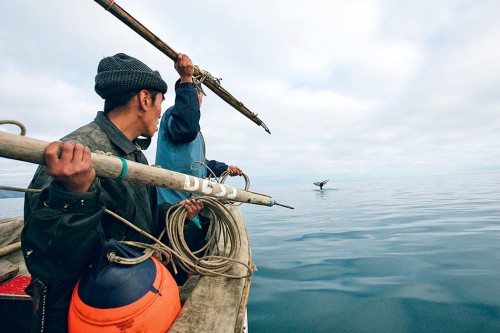
Why does conservation fail?
These and other examples show that with clear rules, rigorous implementation and stringent controls, it is possible to protect the marine environment. But this raises the question why relatively few of the agreements have been successful so far. The Kyoto Protocol, for example, shows how difficult it is to make climate protection a global obligation. The Kyoto Protocol was the first international agreement to establish an absolute and legally binding limitation on greenhouse gas emissions. Under the Protocol, the developed countries pledged to achieve specific greenhouse gas emissions reductions. The Protocol contains detailed regulations on emissions of carbon dioxide (CO2), methane (CH4), nitrous oxide (N2O) and several other greenhouse gases. Although carbon dioxide is not the most potent greenhouse gas, it is released in very large quantities through the burning of natural gas, oil and coal, and is therefore of particular significance. For the first Kyoto commitment period (2008 to 2012), the European Union, for example, pledged to cut its greenhouse gas emissions by 8 per cent compared with baseline year 1990. This target was met. The problem is that not all developed countries acceded to the Kyoto Protocol. The US, for example – the world’s second largest emitter of carbon dioxide – did not sign the Protocol. Making matters worse, no limits were agreed for the developing countries and transition economies because their per capita greenhouse gas emissions are much lower than those of the developed countries. However, with their populations each exceeding one billion, both China and India emit vast quantities of greenhouse gases. Today, China is the world’s largest carbon dioxide emitter and is thus a major contributor to the greenhouse effect. For the sake of the climate, it therefore needs to cut its emissions as a matter of urgency. However, it is also important to consider that a large percentage of China’s carbon dioxide emissions come from heavy industry, which manufactures products for the European and US markets. In that sense, China’s carbon dioxide emissions cannot be viewed in isolation from the importing countries. This shows that effective climate action is, without doubt, a global responsibility.
 4.10 > China is one of the world’s largest producers and consumers of coal. Coking plants are particularly densely concentrated in Linfen in the southwest of Shanxi Province. The US Blacksmith Institute rated the city among the world’s most polluted places in both 2006 and 2007.
4.10 > China is one of the world’s largest producers and consumers of coal. Coking plants are particularly densely concentrated in Linfen in the southwest of Shanxi Province. The US Blacksmith Institute rated the city among the world’s most polluted places in both 2006 and 2007.Climate protection – a lonely pursuit
At the end of the first commitment period, the parties to the Kyoto Protocol met again in order to agree new climate targets for the second commitment period (2013 to 2020). Although the international community agreed fresh targets, this time, it was not only the US but other countries too that rejected the new commitments. Japan, Canada, New Zealand and Russia are no longer partici-pating in the second commitment period. Reduction com-mitments were adopted by the European Union and its member states, Australia, Belarus, Iceland, Kazakhstan, Liechtenstein, Monaco, Norway, Switzerland and Ukraine. Together, however, these countries account for just 15 per cent of global emissions. As a result, greenhouse gas emissions have continued to rise. The Kyoto Protocol is therefore not generally regarded as a success. The future allocation of greenhouse gas reductions remains a contentious issue, as is the question of how the developing countries and transition economies, especially China and India, can be persuaded to cut their carbon dioxide emissions.Short-term thinking vs. climate action
So what are the reasons for the Kyoto Protocol’s and other environmental agreements’ lack of success? From the economists’ perspective, the answer is clear: national implementation of agreements or regulations ultimately depends on the extent to which the benefits outweigh the costs for the country concerned. If a target can be reached at minimal cost, national measures are more likely to be adopted. One example is the new waste ordinance in Oahu, one of the islands in the Hawaiian Archipelago. Since 1 July 2015, the ordinance has banned businesses from handing out plastic bags to their customers. The authorities’ aim is to reduce the amount of plastic waste, much of which ends up as marine litter. The plastic bag ban does not cost Hawaii very much at all, as alternatives such as paper bags and biodegradable plastics have existed for some time. The benefits, however, are substantial, as the ban is helping to keep Hawaii’s beaches litter-free and promotes its image as an unspoilt, near-natural tourist destination.
- 4.11 > Two-thirds of the world’s carbon dioxide emissions are produced by just 10 countries. China and the US are by far the largest emitters.

- Fish stock
A stock is defined as a self-sustaining population of a fish species within a specific sea area. As a rule, the various stocks of a species are so geographically separate that one stock‘s individuals do not mix with another‘s, even though they belong to the same species. In a fisheries context, this means that a species is very rarely totally depleted; generally, this applies only to a specific stock. - Dispensing with fossil fuels is difficult, however, as almost all the national economies are dependent on them. Crude oil is used to produce fuels to power vehicles; natural gas and coal are needed for electricity generation and heating. The transition to alternative technologies such as photovoltaics and wind power is complex and requires major upfront investment, the costs of which seem extremely high compared with other energy sources. However, conventional cost-benefit calculations often ignore the external costs. Energy generation is a case in point: at present, only the costs of the feedstocks used to produce electricity or heating tend to be considered. Coal, a fossil energy source, thus appears to be a cheap fuel.
For that reason, many countries use vast amounts of it. However, this cost-benefit analysis does not factor in the external costs associated with the greenhouse gas emissions produced in the burning of coal. No price is put on the droughts, storms, ocean acidification and sea-level rise caused or exacerbated by climate change.
- 4.12 > Compared with other fossil fuels, the burning of coal releases particularly large amounts of carbon dioxide. Although more oil than coal is burned worldwide, it emits less carbon dioxide. Renewable energy technologies such as photovoltaics, hydro and wind power, but also nuclear power plants produce next to no carbon dioxide emissions during their operation. The above figures do not take into account energy consumption and carbon dioxide emissions from uranium mining, the manufacture of wind turbines and photovoltaic systems and the construction of hydropower plants.

- As the gains from the avoidance of external costs are not considered, many countries continue to rely on fossil fuels. In the transition economies and developing countries, such as China and India, where industrial production is booming, soaring energy demand is therefore met primarily by cheap coal. Many other countries also shy away from the costly transition to low-carbon technology, with the result that global carbon dioxide emissions are still rising. Instead of investing in alternative technologies, private-sector energy suppliers and industry keep costs down for the present by utilizing cheap fossil fuels. Society will have to pay the price in future, in the form of high consequential costs.
Free riders obstruct environmental protection
In a situation like this, the free rider problem occurs. Free-riding countries are those which make little or no contribution to climate protection. They leave it to other states to invest in climate change mitigation and to switch to renewable energies. Without making any con-tribution themselves, they profit from others’ efforts and investment. This in turn deters those countries which would otherwise be willing to invest in protecting the climate and the environment. Due to the free riders, however, they have little incentive to intensify their commitment.
As a consequence, some countries are demanding that the top 10 carbon dioxide emitters – including China, the US, India, Russia, Japan and Germany, which together produce two-thirds of global carbon dioxide emissions – massively reduce their CO2 emissions before they themselves take action. China and India counter with the argument that the leading industrialized countries should take action on the climate first of all. The result is that very little progress is made. On the other hand, China – unlike the US – is now attempting to make more intensive use of renewable energy sources, primarily hydro, wind and solar.
China has therefore greatly expanded its wind energy sector in recent years. By the end of 2014, China’s installed wind power capacity was almost equivalent to that of all the European wind farms combined. The total capacity of US wind farms, by contrast, is only half this amount. However, in some cases, this massive expansion of renewable energies in China is causing major problems. China’s hydropower projects, such as the Three Gorges Dam, are an example. The damming of the Yangtze River has destroyed numerous towns, villages and natural habitats, and this damage is irreversible.
Some progress nonetheless
Despite national self-interests, environmental protection and a sustainable economy are within reach at the international level, as a multitude of examples show. For the marine environment, the European Union’s new Common Fisheries Policy (CFP) is particularly noteworthy; it aims to end the overexploitation of European fish stocks. For many years, the EU’s fishing fleet was far too large, but there was vehement opposition to any restriction on fishing from politicians keen not to lose votes, especially in structurally weak regions. Accordingly, the annual Total Allowable Catches (TACs) set by EU fisheries ministers for the various species were often far higher than recommended by scientists, resulting in the progressive overexploitation of many stocks. Today, stocks are mostly made up of smaller and juvenile fish, which are often thrown back into the sea because they are below the prescribed minimum size. This practice of discarding fish has steadily worsened the problem of overfishing in recent years.
In view of the permanent massive overexploitation of many of the EU’s fish stocks, a change of policy was finally agreed. The new CFP entered into force in 2014. Its aim is to regulate fishing in a way which allows fish stocks to recover, enabling them to be fished at an optimal level in future. Fishery scientists see this as a milestone in the move towards the sustainable exploitation of Europe’s fish stocks. Although discussions on how the new fisheries policy should be implemented day-to-day are still ongoing, a start has been made. From now on, fishing in the EU will be based on maximum sustainable yield (MSY). The MSY is the maximum catch that can be taken from a species’ stock over an indefinite period without jeopardizing that stock’s productivity.
Fishing based on MSY not only gives fish stocks a chance to recover. It also offers a range of economic benefits. If stocks are allowed to grow, this increases fisheries’ catch potential. Future catches will consist of larger fish, which fetch higher market prices per kilo, and discards will decrease. If stocks consist of larger fish, it takes far less time to catch a tonne of fish, reducing fishing effort and cutting fuel and wage costs. Ultimately, higher profit margins and rates of return can be achieved – and that means additional revenue for the fishing industry.
Accurately estimating fish stocks
For fishing to be based on MSY, however, it is essential to know how many fish there are in the sea. The challenge is that the size of a stock naturally fluctuates from year to year. Key environmental parameters determining the number of juveniles produced include water temperature, salinity and oxygen concentration. The food supply also determines how well the fish grow. Today, it is recognized that even regular climatic fluctuations influence the development of fish stocks. So it is not enough to set a specific allowable catch once and for all. On the contrary, fishery scientists must reassess the stock every year to enable them to make catch recommendations for the coming fishing season; in other words, they must determine the total allowable catch, in tonnes, at a level that does not exceed the MSY.
In order to estimate stock size, scientists utilize catch data from fishermen, as well as the findings from catch samples collected during research expeditions. Using ma-thematical models, they then calculate the recommended maximum annual catch.
This process is made more difficult, however, by the fact that a variety of methods exist for calculating the MSY, sometimes resulting in discrepancies in the figures. Fishing in Australia and the US is now based on MSY, but their management regimes differ nonetheless. The International Council for the Exploration of the Sea (ICES) is currently advising the EU bodies on the introduction of appropriate calculation methods.
- 4.14 > Pilot projects are now under way to test the installation of on-board cameras as a means of monitoring catches.
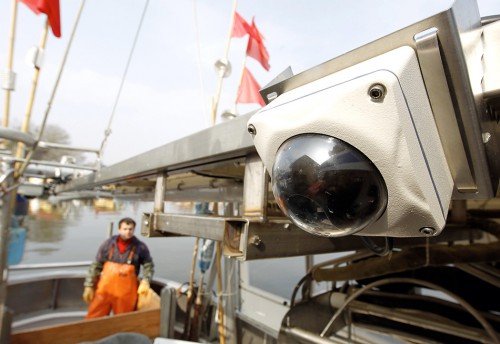
Doing battle against discards
In order to protect and ensure the optimal use of fish stocks in future, the new CFP also envisages various measures to reduce discards. They include the introduction of selective fishing gear specifically designed to catch only the target species. However, even the use of improved fishing gear does not always avoid fish of different species ending up in the same net. Specialists call this a mixed fishery. In cod fisheries, for example, haddock and whiting are often caught as bycatch. This has caused problems because fishermen were only permitted to land the species for which they had been allocated a quota – generally cod. All the other fish and marine fauna caught as bycatch were dumped overboard. Most of the discards were already dead when they went back into the water. In future, fishermen engaged in mixed fishing should acquire quotas for all species likely to end up in their nets. As soon as a quota is exhausted, fishing must cease in order to avoid overexploitation of the species – even if the quotas for the other species have not yet been exhausted. Discussions are currently under way to determine how the EU can best monitor the discard ban. One option is to install sealed CCTV cameras to monitor activity on deck. According to experts, the widespread use of this or other solutions in routine fishing operations is simply a matter of time. From their perspective, EU fisheries policy reform was the most important factor, and this has been achieved with the new CFP.
Centralism gives way to regional responsibility
The new CFP has introduced another change as well: the individual fishing regions will now have a greater say. Previously, all the rules were agreed centrally in Brussels and applied equally to all the EU waters. However, fisheries can vary considerably according to species and region, making it almost impossible to apply all the rules to all the various regions. Some rules were found to be unworkable, so new rules were adopted without amending or repealing the first. The outcome, over time, was an overly complex and sometimes contradictory EU fishing regime. Many of the EU rules were therefore viewed by fishermen themselves as excessive or impractical. Indeed, some of them were ignored altogether.
The new CFP now provides for greater involvement of fishermen in fisheries management and decision-making. For example, Member States can delegate decision-making power to the regional level and give responsibility to the regional bodies where the fisheries directors of the seaboard states are based, such as the Baltic Sea Fisheries Forum (BALTFISH) – the regional body providing a platform for discussion of fisheries issues in the Baltic Sea. These bodies can then draft management plans that are appropriate for their specific region, which will then be approved by the EU’s Agriculture and Fisheries Council. The regional bodies will hold regular consultations with a second tier, namely the Regional Advisory Councils. Up to two-thirds of the members of the RACs are experts from the fisheries sector, with experts from other interest groups, such as nature conservation organizations and trade unions, comprising the remaining one-third.
With its regionalization of fisheries policy, the EU is to some extent following the example of the US, where fishing has been based on MSY for some years and regional fisheries management regimes are in place in various coastal regions and are the responsibility of five regional fishery bodies. In 2013, for the first time, all five regional fishery bodies in the US set their total allowable catches precisely according to the recommendations made by fishery scientists, based on MSY – a move which fishery scientists hail as a success. In addition to the US and the EU, Australia has based its fishing activity on MSY for some time. Here too, fishermen are involved in fishery management at the local level.
Fishing vs. marine conservation?
A further challenge for the EU at present is to bring fisheries management into line with the Marine Strategy Framework Directive (MSFD) adopted in 2008. The general aim of the MSFD is to achieve or maintain good environmental status in the marine environment. There is thus an obligation not only to ensure that fisheries are exploited at sustainable levels, but also to minimize impacts on seabed habitats. Bottom trawling can degrade these habitats even if the fishery in question is sustainable in terms of its impact on fish stocks. According to the MSFD, fishing should in future be managed in such a way that EU sea areas which merit a specific protection regime are no longer fished at all, or are fished less intensively. In the EU, some scientists are currently mapping the seabed and gathering information on which types of organism occur in various seabed habitats, such as mussel beds, seagrass beds and diverse types of sediment. Maps are also being produced to show the level of intensity of fishing in the various areas, so that in future, it will be possible to assess more accurately which specific areas are particularly sensitive and should perhaps be excluded from fishing activities that impact on the seabed.
Various uses in a limited space
If the marine environment is to be protected more effectively, based on the sustainable management of its re-sources, there must, in future, be better coordination between its conservation and use. Marine spatial planning (MSP) is an important tool in achieving this goal. MSP is a means of coordinating the various coastal and marine interests. Economic activities in the marine environment, e.g. fishing, offshore wind farm construction, dredging for marine aggregates (i.e. gravel and sand), shipping and oil production, must be balanced against other uses, such as leisure and recreation and, not least, conservation.
MSP was first developed in the 1980s as a means of resolving conflicts of interest over the conservation and use of the Great Barrier Reef along the east coast of Australia. Experts now take the view that a marine spatial plan should always be based on an ecosystem approach; in other words, a sea area should be managed in a way which avoids negative impacts on marine habitats and the provision of ecosystem services. Ultimately, marine spatial planning should prevent the proliferation of uses which has caused major pollution of coastal waters and environmental problems in many regions of the world in the past. The prerequisite for a successful MSP is that all stakeholder groups and the local community are involved in the planning process.
- 4.15 > The SeaGen tidal energy convertor in Strangford Lough in Northern Ireland is a 1.2 megawatts device whose output is comparable to that of a wind turbine. SeaGen is unusual in that it uses rotors to produce power, whereas the common method of extracting tidal energy utilizes turbines installed in a barrage wall.
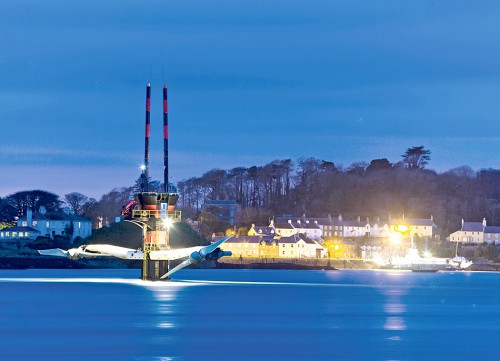
Extra Info Offshore energy – creating space for green power plants at sea

Offshore wind powers spatial planning
Since the start of the new millennium, interest in marine spatial planning has noticeably increased. Contributory factors are the increase in shipping and the trend towards more offshore extraction of mineral resources such as natural gas and oil in many sea areas. In Europe, particularly in the United Kingdom and later also in Germany, the strong expansion of offshore wind power was also a driving force behind the introduction of MSP. The question of how to reconcile wind power expansion with shipping and safety along maritime transport routes was the main focus of attention here. The authorities therefore demand-ed detailed analyses of the potential risks posed by wind turbines, for example in the event of a damaged vessel drifting at sea. Attention also focused intensively on the extent to which large-scale wind farms affect the flyways of migratory birds, and biological assessments were conducted to answer this question. Denmark and the Netherlands, for their part, were keen to assess to what extent offshore construction would jeopardize the status of the Wadden Sea as a UNESCO Natural World Heritage site.
The expansion of offshore energy worldwide seems set to continue, and from a climate perspective, this is a welcome trend. However, this form of energy generation will inevitably clash with aspects of marine conservation and use, not only in Europe. Even during construction, there is potential for conflict. The use of heavy piledriving machinery to ram the foundations of wind turbines into the seabed triggers powerful sound waves which are now known to cause hearing impairment in marine mammals. Although the use of mitigation devices, such as air bubble curtains, to reduce underwater noise is now being trialled, it seems likely that in future, wind farm construction will in some cases have to take the behaviour of marine mammals into account, for example by halting construction to allow whale mothers and calves to pass. And once a wind farm is established, fishing – a key sector of the economy in many coastal states – becomes impossible in that area, so alternatives must be identified. All these aspects must be considered in marine spatial planning in future.
The ecosystem approach The ecosystem approach is a strategy for the integrated management of land, water and living resources that promotes conservation and sustainable use in an equitable way. Instead of applying a species-by-species approach, it focuses on the dynamic rela-tionships within and among species and between species and their natural environment.
The perfect MSP
At first, each country implemented MSPs as it saw fit, with little sign of any harmonized spatial planning. MSP experts from UNESCO’s Intergovernmental Oceanographic Commission (IOC) therefore published guidelines on marine spatial planning in 2009. They set out a step-by-step approach for ideal marine spatial planning in line with ecosystem-based management. As the authors themselves emphasize, these guidelines are a general tool which can be applied at international, regional and local level. According to the guidelines, marine spatial planning should consist of the following 10 steps:- Identifying need and establishing authority;
- Obtaining financial support;
- Organizing the process through pre-planning;
- Organizing stakeholder participation;
- Defining and analysing existing conditions;
- Defining and analysing future conditions;
- Preparing and approving the spatial management plan;
- Implementing and enforcing the spatial management plan;
- Monitoring and evaluating performance;
- Adapting the marine spatial management process.
- 4.16 > Marine spatial planning can also help to mitigate conflicts between wind turbines and the flyways of migratory birds.
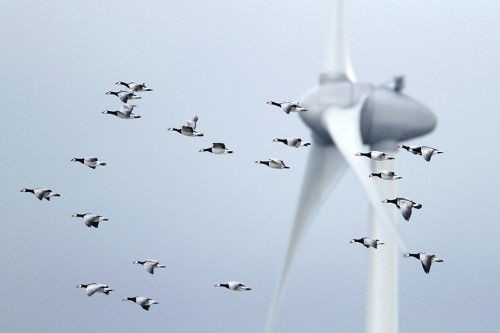
- The authors point out that MSP is a long-term process which must be continuously tailored to changing conditions; this involves further consultation between planning authorities and the various stakeholder groups. Identifying possible alternative sea use scenarios is also important, as is setting specific planning objectives at the outset, which should be measurable. Comprehensive marine spatial planning has many advantages, according to the authors. One is that it allows stakeholders’ common interests to be identified. For example, an offshore wind farm can provide a refuge for certain species of fish, particularly juveniles, as no fishing takes place in this area. Tourist excursions to wind farm sites are another possible option. In sea areas where natural reefs have been destroyed by fishing, the bases of wind turbines can act as artificial reefs for colonization by marine organisms that require a hard substrate. And lastly, various types of offshore energy can be combined; for example, ocean current energy installations can be mounted on the bases of wind turbines, thus making better use of the available space in the sea area concerned.
- 4.19 > Spatial plans for the German EEZ, which have existed since 2009, specify which uses are permitted, and in which areas. As shown above, wind farms may only be constructed outside Natura 2000 sites some distance away from shipping lanes.
Mandatory marine spatial planning
In a number of countries, MSP is now regulatory and enforceable under national law; examples are Belgium, China, Germany, the United Kingdom and the US. In the European Union, a directive requiring Member States to harmonize their maritime spatial planning entered into force in 2014. The aim, among other things, is to avoid conflicts at the borders between EEZs. For example, it should be possible, in future, to avoid a situation in which a marine protected area on one side of the border lies directly adjacent to an area where a neighbouring state plans to dredge for sand and gravel.
With its Federal Spatial Planning Act (Raumordnungsgesetz), Germany is a good example of how multiple interests can be reconciled through regulation. Under the longstanding procedure stipulated by this Act, areas are designated for specific types of land use, such as economic development, nature conservation, and recreation. The areas are then marked on a detailed land use map. This spatial planning model has now been extended to the EEZ and marine spatial plans have been produced.
Initially, the driving force was offshore wind energy as part of the German government’s massive expansion of renewable energies at the start of the new millennium. Unlike shipping and fishing, wind turbines are a static, not a mobile form of use, occupying space in the sea area concerned for at least 25 years. They can thus be regarded as permanent structures. As a wind farm with 100 turbines easily covers an area of 30 to 40 square kilometres, their space requirement is considerable. Risk analyses were therefore conducted to assess to what extent wind farms posed a shipping hazard. As a result, wind farm exclusion zones were identified to prevent collisions from occurring, as were priority areas for wind energy.
- 4.20 > Laying of undersea cables, which is carried out by large specialist vessels such as Team Oman, must also be considered in marine spatial planning.
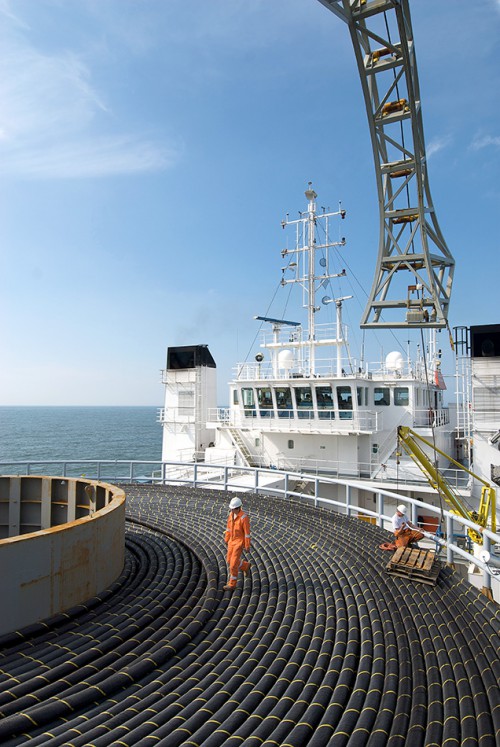
Protected areas in the EEZ
The spatial plans for Germany’s exclusive economic zone (EEZ) entered into force in 2009. Among other things, they show power line routes and marine dredging areas (aggregates), as well as marine protected areas, i.e. Natura 2000 sites. Under various EU directives, each Member State is required to designate Natura 2000 sites, which together form an EU-wide network of nature protection areas, the aim being to combat the fragmentation of Europe’s protected habitats so that rare fauna and flora can regain access to their original areas of distribution. The Natura 2000 sites include some coastal and offshore areas in the Member States. According to experts, Germany has set an example in its spatial planning by designating all the Natura 2000 sites in its EEZ as zero-use zones, whereas it is customary to allow economic uses to continue in Natura 2000 sites provided that assessments are conducted to show that this does not adversely affect their conservation function. Around 30 per cent of Germany’s EEZ in the North Sea and 50 per cent of the EEZ in the Baltic are thus protected. There are some criticisms, however. Before the spatial plans entered into force in 2009, various companies had submitted applications to construct wind farms. For one project, operators were granted a licence prior to 2009. However, this would now be located in a Natura 2000 site. But because approval had already been granted, the project can still go ahead. Spatial plans in Germany are usually revised every seven years or so, but critics are keen to amend the spatial plan now, so that the longstanding permission for the construction of the wind farm in the protected area is withdrawn.
British pragmatism
As Germany has a federal structure and thus consists of a number of constituent states, harmonizing marine conservation requires considerable administrative effort. The spatial plans adopted at federal, i.e. national, level only apply to the EEZ. The states of Lower Saxony (North Sea), Schleswig-Holstein (North Sea/Baltic Sea) and Mecklenburg-Western Pomerania (Baltic Sea) are responsible for protecting the territorial sea. This increases the need for coordination, as the national authorities must first reach agreement with their counterparts in the individual states. Negotiations were required, for example, to identify where the power lines for the wind farms should cross the border between the EEZ and the territorial sea.
A more pragmatic approach to marine spatial planning is adopted in the United Kingdom, which does not have a federal structure and where responsibility for marine spatial planning is not divided among a number of public authorities. In the UK, the Marine and Coastal Access Act 2009 created the Marine Management Organisation (MMO), which has been responsible for marine spatial planning in England and Wales since it was set up. The MMO is an executive non-departmental public body, sponsored by the Department for Environment, Food and Rural Affairs (Defra). The MMO is responsible for various marine activities, including monitoring of fisheries management plans, dealing with marine pollution emergencies such as oil spills or other environmental disasters, and, of course, developing the MSP. The granting of licences or leases for the economic exploitation of marine assets, on the other hand, is a matter for the Crown Estate, the public body which manages the Crown’s property portfolio.
- The MMO has split England’s inshore and offshore waters into 11 marine plan areas, for which planning processes are currently being conducted. For the East marine plan areas, for example, consultations lasting until early 2015 were held with a large number of stakeholder groups and interested parties, including representatives of:
- aquaculture;
- defence and national security;
- energy production and infrastructure development;
- fisheries;
- local communities and elected members;
- local authorities;
- marine conservation;
- marine aggregates;
- ports and shipping;
- telecommunications and cabling;
- tourism and recreation;
- wastewater treatment and disposal.
- In order to involve the various stakeholder groups, the MMO offered the following opportunities for dialogue until early 2015 for the East marine plan areas alone:
- five series of stakeholder workshops attended by over 300 people;
- 400 one-to-one meetings between the MMO and representatives of various stakeholder groups and Members of Parliament;
- local liaison officers based in Lowestoft and Grimsby met with many local stakeholders and attended their meetings and events;
- 23 public drop-in sessions across the East attended by over 700 people;
- specific groups or fora, e.g. Local Authority elected members, Local Government Associations, conserva-tion authorities, etc.;
- international workshops with experts from Belgium, Denmark, Germany, Netherlands, Germany, Norway and the European Commission;
- two decision-makers’ workshops.
Help towards self-help
As is evident from the example of marine spatial planning in Belize (see Box overleaf), which involved numerous experts from various non-governmental and environmental organizations, external assistance is often required. The nature of this external support may vary, but the diverse approaches have, for some years, been subsumed under the heading “capacity building”. Academic insti-tutions take this as meaning the promotion of scientific expertise through joint projects, exchanges or training programmes involving researchers or technical staff.
For development agencies, it tends to refer to the granting of microloans, enabling the unemployed in developing countries to purchase a plot of land or open a small artisanal business with a view to generating their own income.
In other cases, capacity building is the term applied to projects involving direct contact between development workers and local communities. The ultimate goal is implementation of these projects by stakeholders and local project managers, with external support being reduced to a necessary minimum. This approach does not necessarily require millions of euros in development assis-tance. Often, what is needed, first and foremost, are well-qualified facilitators who are able to identify solutions for the community concerned and motivate and provide training for local people.
- Nowadays, many organizations are engaged in projects which focus on the sustainable management of coastal and marine habitats. In most of these regions, poverty and population growth have forced local communities to destroy their natural resource base. One example is the island of Gau, which belongs to Fiji’s archipelago in the southeast Pacific. Agriculture has caused problems on Gau and neighbouring islands. Firstly, areas of rainforest were cleared some years ago to create arable land, which was used to grow food for local communities. Secondly, cattle and pigs were left to roam around, damaging the best farming areas and contaminating vital water resources. The adoption of westernized lifestyles resulted in growing levels of pollution on the island. Settlements lacked a drainage system for the disposal of waste- and rainwater. And last but not least, the clearing of mangroves led to a decline of fishing and caused coastal degradation. With support from the University of the South Pacific, various solutions were developed for the districts of Gau in partnership with local communities. They include the following:
- the establishment of no-take marine areas to support the recovery of fish stocks;
- construction of a stone breakwater to protect coastlines as a partial replacement for the destroyed mangroves;
- replanting of mangroves to provide natural flood protection and act as a nursery for fish;
- planting of native hardwood to protect the villages from storms and provide a timber supply in the future;
- controls on the cutting of trees in forests;
- monitoring and prevention of wildfires;
- promotion of a smokeless stove to reduce the firewood requirement;
- improved animal husbandry, including pens for cattle and pigs;
- construction of small drainage pits;
- sorting and composting of waste;
- planting of pandanus (voivoi), which is used for making mats for sale as an income generation mea-sure;
- planting of village taro gardens and sale of taro fruit (for flour and animal feed) as an additional income generation measure.
A global voice for small-scale fishing
Partnership with people is also a priority for the global research network “Too Big To Ignore” (TBTI). TBTI aims to improve economic conditions for the many millions of people around the world whose livelihoods depend on small-scale fisheries (SSF), as the debate about overexploitation of marine resources has long been dominated by industrial fishing. TBTI therefore aims to promote sustainable fishing so that over the long term, adequate incomes and livelihoods are safeguarded for fishermen.
The network currently comprises more than 60 researchers from 27 developing and developed countries and transition economies, who are initially engaged in collecting detailed data on local fishermen’s living conditions. The researchers and their project partners input the data into an open-access Internet platform, known as the Information System on Small-scale Fisheries (ISSF), which also contains specialist literature on the various fishing regions in all the coastal nations. The information can be accessed by clicking on a map on the relevant webpage.
TBTI thus aims to elevate the profile of small-scale fisheries, as artisanal fishermen are still marginalized in many countries. The network will also explore how fishermen’s living conditions can be improved, especially in the West African region, whose coastal waters are already overexploited to some extent as a result of industrial fishing.
The network further looks at economic relationships, such as fishermen’s pay, commercial channels for the distribution of fish, and the proportion of the final price that is received by the fishermen. Possible impacts of climate change and potential strategies for adapting to future sea-level rise are also analysed.
- 4.23 > Small-scale fisheries are still very important in many countries. Fishing techniques vary considerably from country to country. The photo shows traditional stilt fishermen near the town of Galle on the Sri Lankan coast.
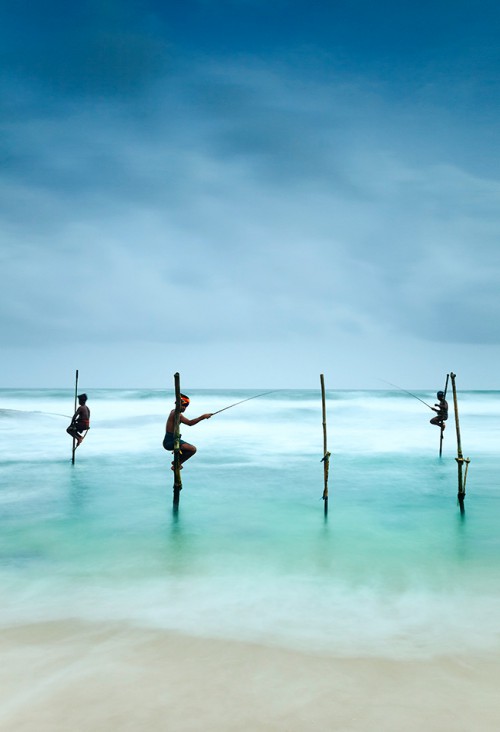
Laying the foundations
An interesting example of capacity building at academic level is a programme run by the International Ocean Institute, which has offered an annual Ocean Governance workshop in Canada for young professionals from va-rious disciplines from all over the world for more than 30 years. The aim is to deepen young people’s understanding of the ever-increasing importance of the oceans as they embark on their careers, thereby laying the foundations for participants to act as advocates for marine conservation throughout their professional lives. To date, around 600 people have participated in the workshops in Canada and many of them now hold positions in which they maintain close contacts to policy- and decision-makers. Many of the workshop participants have stayed in contact with each other and continue to advocate for ocean governance. They include a public prose-cutor in Sri Lanka’s Ministry of Justice and the Principal Research Officer at the Institute of Marine Affairs of Trinidad and Tobago. All in all, there is considerable commitment worldwide to marine conservation, and it seems that nowadays, many more people are aware of the importance of the oceans and the sustainable management of marine resources than was the case only a few years ago. .
- 4.24 > After the Amoco Cadiz oil tanker disaster off the coast of Brittany in March 1978, there were massive protests against oil pollution, as seen here in the French port of Brest. As a result of these protests, much more stringent tanker safety standards were introduced over the years.

Pressure from the grassroots
Marine conservation can be achieved in various ways: first and foremost, of course, through appropriate policy decisions, legislation, monitoring and sanctions However, policy-makers only tend to take action under pressure from civil society – and civil society can only exert pressure if the public is well-informed and has an understand-ing of the sustainable management of the marine and coastal environment.
The pressure that the public can exert should not be underestimated. For example, the IMO requirement for tankers to be fitted with double hulls was introduced, not least, as a result of massive public protests and media coverage, which became increasingly vehement over the years with each major tanker disaster. The fact that such disasters had to happen before action was taken should give us pause for thought. Farsighted planning for future sustainable development is therefore imperative.
